Livestock development program aims to ensure that the interest of poor livestock keepers are reflected in national as well as international policies and programs affecting their livelihoods.
Characteristics of Kadaknath poultry breed
- Black coloured meat
- Black coloured plumage
- Black hued internal organs
- Body weight at 20 weeks = 920g
- Body weight of adult cockerel = 1.5 – 2Kg
- Body weight of adult hen = 1 – 1.5 Kg
- Age at sexual maturity = 180 days
- Annual egg production = 105
- Egg weight at 40 week = 49g
The skin, beak, shanks, toes and soles is dark gray coloured, whereas tongue is dark gray or light black in colour. Comb, wattles and earlobes are light to dark gray or have purple hue. Most of the internal organs of the kadaknath breed show intense black colouration due to the deposition of melanin pigment in the organs. The birds survive well in hot semi-arid climatic conditions with temperatures ranging between 12ᵒ to 42ᵒC. They thrive well in harsh growing conditions such as poor housing, poor management, and poor feeding environments. The other important factor for this chicken breed to be unique is due to its fat content, while in all other chicken breeds the fat content varies from 12 to 26%, kadaknath chicken fat content is 0.70 to 1.05%. The breed population has sharply declined due to the high consumer demand and lack of commercial farmers.
The three main varieties of Kadaknath breed are
- Jet black – the jet-black adult males and females are black in colour
- Penciled – adult male and female plumage is black with white feathers on neck.
- Golden – adult male and females are basically in colour with golden feathers on head and neck.
Although the desi poultry has been reared for ages, losses were found to be high with approximately 40% eggs either infertile or damaged. Moreover 30 – 35% of chicks are lost due to disease and predation. However, most households start keeping the Desi birds all over again by purchasing a few chicks/birds – indicating the importance attached by tribal to backyard poultry.
Kadaknath bird commands an elevated position since
- A year old Kadaknath bird fetches Rs. 800 to 900/-
- Boneless Rs. 1500/-
- and the eggs are sold at Rs. 40 – 50/egg.
- Kadaknath hen lays around 120-130 eggs in a year
Kadaknath chicken benefits
- Kadaknath chicken contains 25 to 27% of the protein in comparison with other breeds of chicken that contain 18% protein. It is known for its high iron content.
- Kadaknath has fat and cholesterol content lower compared with other chicken breeds. Kadaknath is vey popular among local tribal people mostly due to its adaptability to the local environment, disease resistance, meat quality, texture and flavour.
- Protein content in kadaknath is higher than 25%, whereas in an ordinary bird it varies between 18 to 20%.
- Kadaknath black chicken has lower cholesterol (0.73 – 1.05%) than white chicken (13 – 25%).
- This breed chicken having a number of vitamins B1, B2, B6, B12, C, E, Niacin, protein, fat, calcium, phosphorus, iron, nicotinic acid etc.
- This chicken has high levels of 18 essential amino acids as well as hormones that are required by the human body.
- The amount of fat deposited in the body of a kadaknath breed chicken is itself very negligible.
- It has great importance in treating nervous disorder.
Kadaknath egg benefits
- The Kadaknath eggs are an ideal nutritive and used for old people and high blood pressure victims since the cholesterol content is lower rich in amino acids and higher than that of other kinds of poultry birds.
- Kadaknath breed eggs help to meet the day to day protein requirement of growing children.
- The eggs of Kadaknath can be used to treat severe headaches, faintness, asthma, and nephritis (acute or chronic inflammation of the kidney).
Kadaknath breed care
Shelter and care: suitable land is selected in which maximum chick development and egg development takes place. The shelter must be at some height from the road so that rainwater will easily flow out and will protect them from the flood. Freshwater supply should be there. It should have 24 hours of electricity supply. The chicken shelter should be away from the industrial and urban area because the fertilizer of chicken pollutes the environment and causes flies’ problem. Shelter should be free from noise as the noise pollution will affect the production of birds. The smoke of factories will also affect the kadaknath birds.
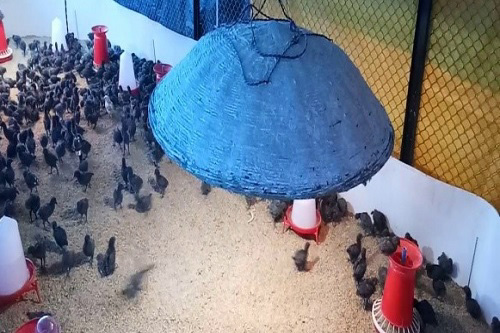
Care of newborn chicks: raising baby chicks requires good attention and an incubator. Eggs are placed in the incubator for about 21days by giving proper temperature. Aaafter hatching, chicks can be removed from the incubator after 48 hours. Handling of chicks must be done carefully while taking out from the incubator. After taking out chicks from the incubator, they are positioned in the brooder. For the first week, the temperature of brooder must be 95ᵒF and it must be dropped by 5ᵒF for every following week. Balanced feed should be given to chicks and clean water must be available every time in the brooder.
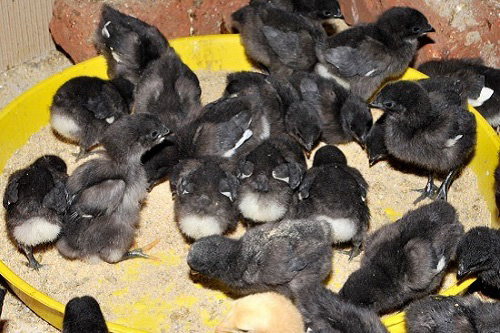
Growth performance in Kadaknath breed of poultry
This Kadaknath breed has evolved through natural selection in indigenous agro-ecological conditions and is well adapted to the local environment. The kadaknath birds reveal an important degree of resistance to diseases compared with exotic breeds of fowl in its natural habitat in free range. Kadaknath birds are resistant to extreme climates like the summer heat and cold winter stress and can thrive well below adverse environments like poor hosing, poor feeding, and poor management. It has high feed conversion ratio, these birds can gain body weight of 1.10 to 1.25 Kg in 100 to 125 days. Kadaknath chickens are best appropriate for backyard farming rather growing on commercial scales.
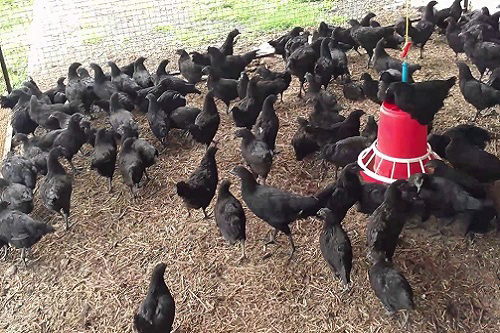
Kadaknath chicken feeding schedule
| Ingredients | Brooder mash (0-8 weeks) in grams | Grower mash (9-19 weeks) in grams | Layer mash (20-72 weeks) in grams |
| Maize | 59.00 | 40.00 | 57.00 |
| Bajra | – | 10.00 | – |
| DORB | 4.00 | 23.80 | 5.00 |
| Soya Meal | 24.50 | 10.70 | 14.40 |
| Sunflower Meal | – | 7.00 | 7.00 |
| Fish Meal | 10.00 | 6.00 | 9.00 |
| Mineral mixture | 2.00 | 2.00 | 2.00 |
| Shell grit | – | – | 5.00 |
| Salt | 0.50 | 0.50 | 0.50 |
| Methionine | – | – | 0.10 |
Kadaknath chicken can be given pre-starter broiler feed with maize crumbs in the first two month period. 20% protein diet can be given to birds once they cross two months. Feeding can be started with broiler starter feed followed by aa regular feed depending upon the body weight and age.
Kadaknath chicken vaccination schedule
There are mainly three recommended vaccines for Kadaknath chicken breed
- F1 vaccine in the first-weekend (costs< Rs.100 for 500 birds)
- IBD vaccine in the second-weekend (costs< Rs.200 for 500 birds)
- RD vaccine in the sixth month
Updated vaccines are required for Kadaknath chicken breed good growth.
Some main vaccines or medicines which are required for maintaining chicken’s good health are as follows
- When the chick is one day then give HVT vaccination to protect them from Marek’s disease. The influence of this injection will remain upto 18 months.
- When the chick is 4 to 7 days old give them RD vaccination (F1 strain) to protect them from Ranikhet disease. The influence of this injection will remain for 2 to 4 months.
- When the chick is 18 to 21 days old give them IBD vaccination to protect them from Gumboro disease.
- When the chick is 4 to 5 weeks old give them RD (F1 strain) vaccination to protect them from Ranikhet disease.
- When the chick is 6 to 8 weeks old give them RD (F2B) vaccinated to protect them from Ranikhet disease. 0.5ml of medicine is applied to the chick.
- When the chick is 8 to 10 weeks old give them chicken pox vaccination to protect them from chicken pox disease.
Cost and profit analysis of Kadaknath chicken unit of 500 birds:
Capital cost
Shed construction (3 sheds x (60x30ft)) (Minimal local materials used) = Rs. 50,000/-
- Recurring cost:
500 chicks (one week old) @ 35 per chick = Rs. 17,500/-
Company Feed (15 quintals) = Rs. 18000/-
Home feed (17.5 quintals) = Rs. 15500/-
Medicines = Rs. 1500/-
Total Recurring cost = Rs. 52,500/-
- Income A: From Birds (mortality 15 birds):
Sale of 35 birds after 5 months @ 200 per bird = Rs.7000/-
Sale of 120 birds after 6 months @ 400 per bird = Rs. 48,000/-
Sale of 180 birds after 7 months @ 400 per bird = Rs. 72,000/-
Sale of 150 birds after 8 months @ 400 per bird = Rs. 60,000/-
- Income B: From eggs (each bird laying 105p.a.):
Total eggs produced: 450
Eggs for incubation: 200 = Rs. 3000/-
Sale of 250 eggs @ 15 each egg = Rs. 3750/
Total income (A+B) = Rs. 1,93,750/-
Net Profit (Income – Recurring cost) = Rs. 1,93,750 – 52,500 = Rs. 1,41,250/-
On an average from the sixth month onward, every month a farmer can make a profit of about Rs. 50,000/- after all farm running expenditure in the wholesale market and almost more than double profit in retail sales. Kadaknath cockerel is sold anywhere between Rs. 750 to 1500/- during festival season.
Hurdles in Kadaknath farming
Inadequate availability of kadaknath breed chicks and lack of proper financial support from government are posing the main hurdle. For better development of this breed, local governments should give subsidies and loans to small scale farmers.
Comparing Desi with Kadaknath Poultry Bird
| Sr.No. | Variables | Desi | Kadaknath | |
| 1 | Market Price (Rs) | 6 months | Cockerel: 80-90 Hen: 70-90 | Cockerel: 100-150 Hen: 90-100 |
| 12 months | Cockerel: 150-200 Hen: 120-150 | Cockerel: 250-300 Hen: 150-250 | ||
| 2 | Annual Egg Production | 40-60 | 80-90 | |
| 3 | Egg Spoilage during Hatcing | 25-30% | 20-25% | |
| 4 | Size of Egg (Grams) | 28-40 gm (Average 32.66) | 32-46 gm (Average 40.66) | |
| 5 | Price of Egg (Rs) | 3 – 4 | 4 – 5 | |
| 6 | Colour of Egg | Light Brown | Dark Brown | |
| 7 | Tenderness of Meat | Hard | Sooft and Lean | |
parative Economics of Kadaknath Backyard Poultry Production System
| Variable | Kadaknath | Desi | |
| Number of Hens | 1 | 1 | |
| Average No. of Eggs laid in a Year | 84 | 50 | |
| Egg Spoilage (30%) | 25 | 15 | |
| Egg Consumption | 20 | 15 | |
| Total Loss + Consumption | 45 | 30 | |
| Chicks Hatched | 39 | 20 | |
| Chick Mortality | 6 | 5 | |
| Chicks Survived | 33 | 15 | |
| Consumtption of Birds | 5 | 5 | |
| Birds availablke for Sale | 28 | 10 | |
| Value of offspring at 12 months (Considering 50% cockerel & 50% hens) | Cocks | @ Rs 250 = 3,500 | @ Rs 150 = 750 |
| Hens | @ Rs 150 = 2,100 | @ Rs 120 = 600 | |
| Total Income | 5,600 | 1,300 | |
|
Expenditure |
|||
| Purchase of Hens @ Rs 200 per hen | 200 | ||
| Feed | 120 | 120 | |
| Health Care Expenses | 5 | ||
| Total Expenditure | 325 | 120 | |
| Annual Net Income | 5,275 | 1,180 | |
Estimate annual income to a tribal family from 1 Kadaknath Bird is around Rs. 5,000.
The mission is to create opportunities of gainful self-employment for rural families, especially disadvantage sections, insuring sustainable livelihood, enriched environment, improved quality of life and good human values. This is being achieved through development research, effective use of local resources, extension of appropriate technologies and upgradation of skills and capabilities with community participation.


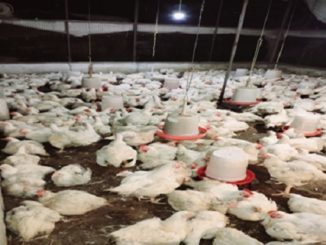

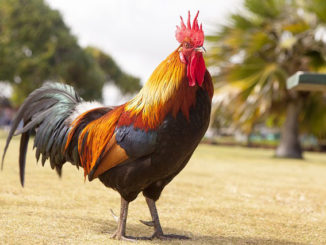

Be the first to comment